Documents: Go to download!
User Manual
- User Manual - (English)
- Specification - (English)
- Description
- Use
- Cleaning and maintenance
Table of contents
User Manual Refrigerator
Description
General Description

1. Freezer compartment
2. Fan
3. Interior lighting
4. Refrigerator compartment
5. Freezer door
6. Timer
7 Freezer door
Description of parts
Freezer compartment
For storing frozen foods, freezing fresh foods and producing ice cubes.
Fan
Distributes the temperature and reduces condensation on the shelves and other surfaces.
Interior lighting
The interior of the appliance is lit when the door is opened.
Refrigerator compartment
For storing fresh foods.
Timer
For setting the temperature inside the refrigerator and freezer compartments.
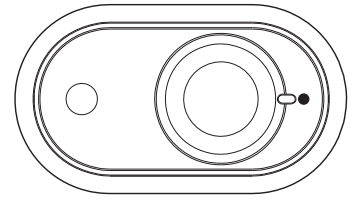
Available accessories
Shelves

For optimising fridge space and placing foodstuffs inside the refrigerator compartment.
Fruit and vegetable drawer
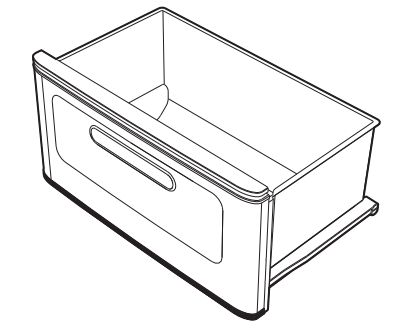
For storing fruit and vegetables, maintaining a constant humidity level.
Supercold drawer
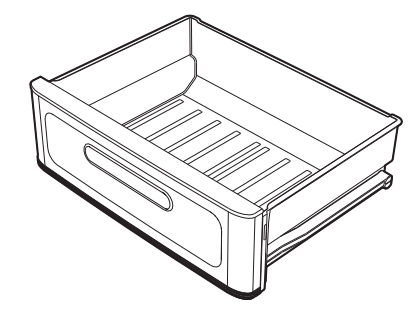
Can be used for maintaining freshness and flavour of delicate food such as meat, fish and lightly frozen foods for a longer time period, since temperature is kept constantly between −2 °C and +3 °C.
Door balconies and shelves
For storing foodstuffs in small containers. The shelf in the lower part of the door is useful for storing bottles.
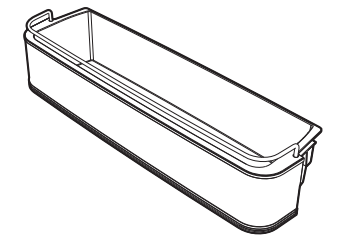
Use
Preliminary operations
1. Remove any protective film from the outside or inside of the appliance, including accessories.
2. Remove any labels (apart from the technical data plate) from the accessories and shelves.
3. Remove and wash all the appliance's accessories (see 4 Cleaning and maintenance).
First use
Plug the appliance into a wall socket. To turn the appliance on, rotate the thermostat knob from position 1 to position 5, depending on the desired temperature.
Alarm for door open
When the appliance door is left open for a long period of time, a sound and visual signal (flashing interior lights) will inform the user to close the door.
Using the accessories
Shelves
These can be positioned at different heights on the guides according to requirements. Each shelf has a safety fitting to prevent it from being accidentally removed.
To extract them fully, lift up the rear part (1) and remove them (2).
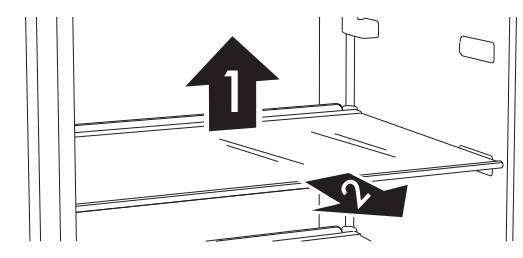
Door balconies and shelves
Suitable for storing eggs, butter, dairy products, conserves and other small food packages/containers. The lower part of the door has a shelf for bottles. Avoid placing excessively heavy bottles on the shelf and do not let them drop onto the bottom when inserting them
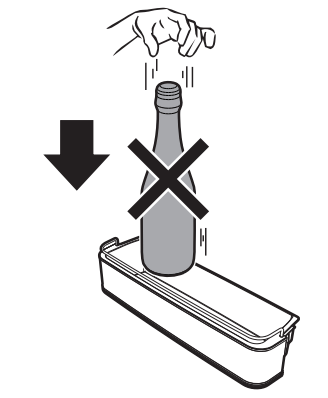
Fruit and vegetable drawer
Located at the bottom of the refrigerator compartment, which is fitted with a glass shelf to cover fresh foods that require constant humidity for optimum storage.
Ventilation
The forced recirculation air in the appliance is free of humidity and quickly dries the food inside.

The inner ventilation system cools food more rapidly and keeps refrigeration homogeneous inside the appliance.
Using the refrigerator compartment
Arranging food
Arrange food on the various shelves, making sure that they are wrapped and covered hermetically. This precaution ensures that:
• the flavour, moisture and freshness of the foods is preserved;
• any contamination of foods with odours or tastes from other foods can be avoided;
• the humidity level inside the refrigerator is prevented from becoming too high as a result of the normal transpiration of food (especially fresh fruit and vegetables). In some operating conditions (rise in ambient temperature and humidity, more frequent opening of the door) this might cause condensation to form on the shelves.
Storage life table

Using the freezer compartment
To keep and freeze foods properly:
• pack fruit and vegetables in portions of no more than 1 kg; meat and fish in portions of up to 2 kg.
• small packages freeze quickly which means that the foods' nutritional properties are preserved better, including after defrosting/preparation.
• package foods in hermetically sealed packages, expelling air as much as possible.
• Do not use paper bags or shopping bags, use the suitable freezer bags/ containers.
Frozen foods storage life table
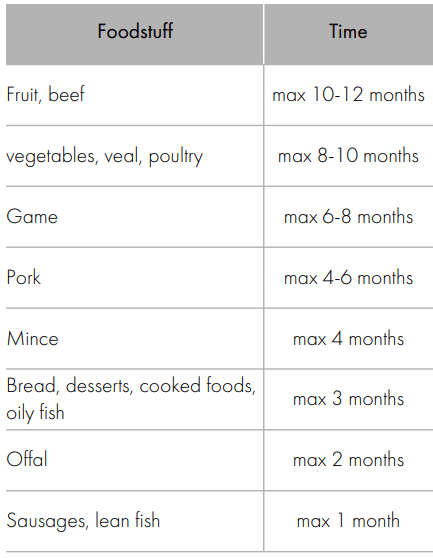
Defrosted foods
Food must be consumed as soon as possible once defrosted. Freezing foods preserves them, but it does not destroy any micro-organisms, which are activated after thawing, damaging the foods. Partial defrosting lowers the nutritional value of the foodstuffs, particularly of fruit, vegetables and ready meals.
Noises during operation
The refrigerator and freezer compartments are cooled by means of a compression system. In order to maintain the preset temperature inside the refrigerator and freezer compartments, the compressor comes into operation in response to the level of cooling required, and may operate continuously if necessary. When the compressor starts to function, it creates a buzzing noise which generally diminishes in intensity after a few minutes. Another normal operating noise of the appliance is a gurgling due to the coolant flowing through the pipes in the circuit. This noise is normal and does not indicate an appliance malfunction. If it becomes too loud, this may mean that there are other causes. Checks must then be made to ensure that:
• The refrigerator is properly levelled on the floor and does not vibrate when the compressor is in operation: if this is not the case, adjust the appliance's feet until it is level;
• The drawers, shelves and trays on the door are correctly positioned in their holders: if they are not, put them in correctly;
• Bottles and containers on the various shelves are stable and not touching each other: otherwise, the vibration resulting from compressor operation could generate noise;
• Do not place the fridge in such a way that it is in contact with furniture or other household appliances.
Heated front surface
There is a front surface heating system inside the cabinet to limit the formation of condensation around the door seal.
Turning the appliance off
Whenever the appliance is to remain unused for long periods, it should be switched off.
1. Unplug the appliance from the wall socket.
2. Empty the compartments.
3. Once the freezer has fully defrosted, dry any residual accumulated moisture with a tea towel.
Food storage advice
Practical energy-saving advice
• Correct use of the appliance, correct packaging of foodstuffs, a constant temperature and food hygiene have significant effects on the quality of storage.
• Reduce the number of times that the doors are opened and the length of time they remain open to prevent the compartments from heating up excessively.
• Clean the condenser at the rear of the appliance periodically to prevent the appliance from losing efficiency.
• Defrost frozen food in the refrigerator compartment in order to make use of the cold stored in the frozen foods.
General advice
• Always check the expiry date on the food packaging.
• The foodstuffs must be stored in closed or pre-packaged containers and must not be able to emit or absorb moisture and odours.
• Remove perishable products from the appliance if you are going away for a long period.
Refrigerator compartment door
• Keep eggs, butter, cheese etc. in the upper and central parts.
• Keep drinks, bottles, cans etc. in the lower part.
Refrigerator compartment
• Keep conserves, wine, biscuits etc. in the upper part.
• Keep dairy products, ready meals, pastries, fruit juices, beer etc. in the central part.
• Keep meats, cold cuts etc. in the lower part.
• Keep fresh and tropical fruit, vegetables, carrots, potatoes, onions, etc. in the fruit and vegetable drawer.
Freezer compartment
• The type of food, quantity and date of freezing should be marked on the container/packaging.
• Use small containers, if possible already cold.
• The quantity of fresh foods which can be frozen at the same time is listed on the nameplate inside the refrigerator compartment.
• Use suitable freezer bags, tinfoil, cling-film for use with food, and freezer containers.
• Do not use paper bags, cellophane for non-food use, shopping bags or pre-used freezer bags.
• Avoid frozen food coming into contact with fresh food to be frozen.
• Keep bagged frozen vegetables, ice, ice cream etc
Cleaning and maintenance
Cleaning the appliance
A special antibacterial protection on the appliance's interior walls prevents bacterial growth and keeps them clean. They must nevertheless be cleaned regularly in order to keep them in good condition.
Cleaning the outside of the appliance
• The appliance may be cleaned with water or alcohol-based liquid detergents (e.g. window cleaning products).
• Avoid aggressive detergents and rough sponges in order not to damage the surfaces.
• Use a soft brush to remove dust and fume deposits from the condenser on the rear of the appliance.
• Clean the tank above the compressor.
Cleaning the inside of the appliance
• Clean the inside of the appliance with diluted liquid detergent and warm water, adding a little bit of vinegar.
• Door balconies and shelves can be removed.
• Do not use sharp objects or spray products.
Defrosting
Defrosting the refrigerator compartment
The refrigerator compartment does not require defrosting, as any ice which forms on the refrigeration plate will melt when the compressor is idle. The defrosting process is automatic.
Defrost water is channelled directly into the dedicated pan on the back of the appliance, which lets it evaporate by means of the heat generated by the compressor
Defrosting the freezer compartment
The freezer compartment needs to be defrosted manually. When the thickness of frost or ice exceeds 2 cm, the freezer should be defrosted.
A few hours before defrosting, set the thermostat to the max. value in order to further lower the temperature of the frozen foods. Unplug the appliance from the supply mains socket. Remove the frozen foods from the freezer compartment and protect them from thawing while cleaning. Wait until ice thaws and then remove water from the freezer compartment using a sponge/absorbing cloth.
Interior lighting
Interior lighting, if damaged, must be repaired by Technical Service only.
What to do if...
The appliance does not work:
• Make sure that the appliance is plugged in and that the main switch is turned on. The compressor starts to function too often or functions continuously:
• The room temperature is too high.
• The door is being opened too often or for too long.
• The door is not closing/sealing properly.
• The freezer is loaded with too many fresh foods.
• Check that sufficient air can circulate around the sensor on the right-hand side of the refrigerator compartment.
• Check that the back of the freezer is properly ventilated and that the condenser is not too dirty.
Excessive ice or condensation has built up inside the refrigerator compartment:
• The door is being opened too often or for too long.
• Hot foods have been placed inside the refrigerator compartment.
• The foodstuffs or containers are in contact with the rear wall.
• The door seal is damaged or dirty. Clean or replace it.
The refrigerator compartment is not sufficiently cold:
• The thermostat is set at too high a temperature.
• The door is being opened too often or for too long.
• The door is not closing/sealing properly.
• The room temperature is too high.
The temperature inside the refrigerator compartment is too cold and the foodstuffs are freezing:
• The thermostat is set at too low a temperature.
• Food not contained in suitable containers or bags.
• Fruit and vegetables might be too wet.
• Foodstuffs placed against the rear wall of the refrigerator compartment.
Temperature inside freezer compartment not low enough to freeze foods properly:
• The thermostat is set at too high a temperature.
• The door is being opened too often or for too long.
• The door is not closing/sealing properly.
• The door seal is damaged or dirty. Clean or replace it.
• The food to be frozen contains large quantities of sugar.
Excessive ice has built up inside the freezer compartment:
• The thermostat is set at too low a temperature.
• The room temperature is too high.
• The door is being opened too often or for too long.
• The door is not closing/sealing properly.
• The door seal is damaged or dirty. Clean or replace it.
• Hot foods have been placed inside the freezer compartment.
Doors are hard to open just after closing:
• If you attempt to open the door again just after closing it (especially the freezer door), considerable strength is required. This is due to the vacuum created by the cooling of the warm air which has entered the freezer.
The doors are misaligned:
• Check that the appliance is level.
• Level the appliance using its feet.
See other models: KD90HXE FT41BXE PV364LCN KSET91E CO103
